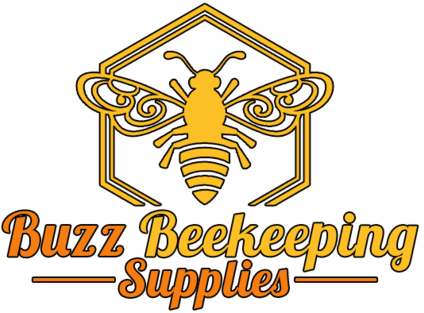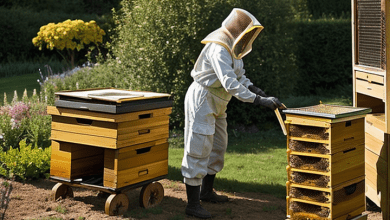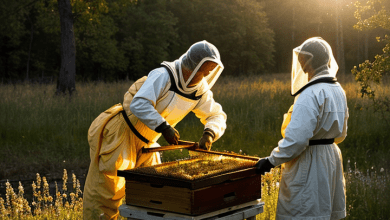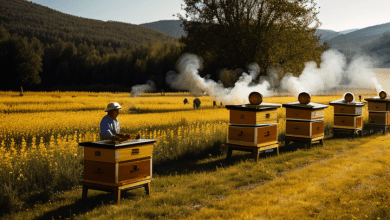Beekeeping Supplies Utah

Beekeeping has become a popular hobby for many residents of Utah, and with good reason. Not only does beekeeping provide an endless supply of delicious, local honey, but it also helps to support and maintain the local ecosystem.
Beekeeping supplies are essential for anyone interested in starting their own hive, and luckily, Utah has a wide variety of stores and suppliers to choose from.
No matter where you are looking for beekeeping supplies in Utah, we’ve got you covered.
Beekeeping in Utah
Beekeeping in Utah offers a vast array of flora for bees to forage, resulting in unique honey flavors and thriving colonies. By understanding Utah’s climate, selecting the right location, and taking proactive pest management measures, beekeepers can enjoy a successful and rewarding beekeeping experience in the Beehive State.
Utah ranks number 22 in the United States in honey production, with a yield of 1,196,000 pounds annually.
Beekeeping Equipment
Beekeeping is a vital and fulfilling practice that necessitates the use of proper equipment to guarantee the health and prosperity of honeybee colonies. Before delving into the world of beekeeping, it is crucial to have a comprehensive understanding of the essential bee supplies required.
The Components of a Beehive
- Hive Boxes: Hive boxes, also referred to as supers, are indispensable elements of a beehive, serving as the living quarters for honeybees and their honeycombs. Beekeepers have the option to select from various hive styles, including Langstroth, top bar, and Warre hives, based on their preferences and the specific needs of their bees. The quality of hive boxes is paramount, as they need to accommodate different stages of bee colony growth while ensuring the comfort and productivity of the honeybees.
- Frames: Suspended within each hive box, frames provide structural support for the honeycombs and serve as a foundation for brood rearing and honey storage. Wooden frames, used in conjunction with a plastic foundation, are commonly employed by beekeepers due to their balance between strength and ease of use. Well-assembled frames are essential in aiding the bees’ organization of their colony and facilitating effective beekeeping management.
- Bottom Boards: Functioning as the base of the beehive, bottom boards offer stability and ventilation while serving as an entrance for the honeybees to freely enter and exit. They also serve as a line of defense against intruders. In regions with extreme climates, such as Utah, it is imperative to select bottom boards that can withstand temperature fluctuations and provide sufficient ventilation to prevent moisture buildup, thereby ensuring the health and productivity of the bees.
- Inner Covers and Outer Covers: Completing the structural integrity of the hive, both inner covers and outer covers provide insulation and protection to the honeybees. Inner covers add an additional layer of insulation, while outer covers shield the hive from harsh weather conditions such as rain, snow, and wind. These covers play a critical role in the survival of the hive and contribute to maintaining a stable environment for the honeybees.
In conclusion, acquiring the right beekeeping equipment is vital for successful hive management and is crucial in ensuring the well-being and productivity of honeybee colonies.
Protective Gear for Beekeepers
Beekeeping is a complex and rewarding activity that requires a deep understanding of bee behavior and the necessary precautions to ensure the safety of beekeepers. One of the most crucial aspects of beekeeping is investing in high-quality protective gear to protect against bee stings and ensure comfort during hive inspections and honey harvesting.
Bee Suit: A bee suit is a vital piece of protective clothing that every beekeeper should invest in. It provides essential protection against bee stings and offers maximum coverage during beekeeping activities. When considering a bee suit, there are two main types to explore:
- Canvas Beekeeping Suits: Renowned for their durability and excellent sting resistance, canvas beekeeping suits provide robust protection for beekeepers. These suits are designed to withstand the rigors of beekeeping activities while ensuring the safety and comfort of the wearer.
- Ventilated Bee Suits: Designed with a breathable mesh fabric, ventilated bee suits allow beekeepers to work comfortably in hot weather conditions while still ensuring protection from bee stings. These suits are ideal for beekeepers who operate in warmer climates and need breathable protective gear.
Bee Gloves: Selecting the right pair of beekeeping gloves is essential in safeguarding your hands from stings while maintaining dexterity. There are two primary options to consider:

- Goatskin Bee Gloves: Known for their exceptional tactile sensitivity, goatskin bee gloves enable beekeepers to handle delicate tasks with ease while providing protection from stings. These gloves offer a balance of protection and dexterity, making them an ideal choice for beekeepers.
- Cowhide Bee Gloves: Providing robust protection due to their thick leather construction, cowhide bee gloves ensure the safety of beekeepers’ hands. These gloves are designed to withstand the impact of bee stings and provide added durability during beekeeping activities.
Beekeeping Boots: When tending to honeybee colonies, protecting your feet is equally important. Beekeeping boots are specifically designed to prevent bees from accessing your feet, offering a vital addition to your beekeeping supplies. These boots provide an essential barrier against bee stings and ensure the safety of beekeepers during hive inspections and maintenance.
Veil: A reliable beekeeping veil is essential for safeguarding your face and neck from bee stings. Crafted from a fine mesh, these veils allow for excellent visibility while ensuring bees cannot reach your skin. Investing in a high-quality veil is crucial for protecting sensitive areas of the face and neck during beekeeping activities.
Purchasing Options and Considerations
In many cases, beekeepers can purchase a combo pack of a bee suit and bee gloves at a discounted price, providing a convenient and cost-effective solution for acquiring essential protective clothing for beekeeping. When considering protective gear, it is essential to prioritize quality and durability to ensure long-lasting protection and comfort during beekeeping activities.
Beekeeping Tools
As a beekeeper in Utah, it is important to have the right tools to effectively manage your hives.
- Bee Smoker: The bee smoker is an essential tool for calming honeybees during hive inspections. It plays a crucial role in making it easier and safer for beekeepers to work with their bees. By producing cool smoke that masks the alarm pheromones released by guard bees, the smoker helps pacify the colony and reduce the risk of stings. Additionally, the smoke triggers a feeding response in the bees, causing them to be less inclined to sting. A beekeeper should always have a smoker and extra fuel on hand to effectively manage their hives.
- Hive Tool: The hive tool is a versatile instrument used to separate and pry apart hive components during inspections. Its flat blade and curved hook allow beekeepers to lift frames, scrape off excess propolis, and remove burr comb. The sturdy construction of the hive tool ensures that beekeepers can efficiently dismantle and reassemble their hives without causing any harm to the bees or their equipment.
- Bee Brush: The bee brush is designed to cater to the care and well-being of the bees. This soft-bristled brush allows beekeepers to gently move bees away from specific areas during inspections without causing harm or stress. It helps keep the bees calm and prevents them from getting unnecessarily crushed or injured, making it an essential tool for maintaining harmony between beekeepers and their precious honeybees.
- Queen Marking Tools: Queen marking tools are crucial for identifying and tracking the queen bee within a colony. These tools consist of small, colored plastic or metal markers that can be applied to the queen’s thorax. This marking helps beekeepers easily locate and follow the queen during hive inspections, reducing the risk of accidentally harming or misplacing her. The color code system established by beekeeping associations provides vital information about the age and year of the queen, allowing beekeepers to monitor their colonies’ health and longevity effectively.
Having the right beekeeping tools is essential for the successful management of hives in Utah. Each of these tools serves a specific purpose and contributes to the well-being of the bees and the smooth operation of a beekeeping business.
Hive Feeders:
Beekeepers are essential in ensuring that their bees have consistent access to a reliable source of food. While bees primarily gather nectar and pollen from flowers, supplemental feeding becomes necessary during periods of scarcity or when establishing new colonies.
Hive feeders are indispensable tools that enable beekeepers to provide essential nourishment to their bees. These feeders are designed to hold various types of supplemental food, such as sugar syrup or pollen substitute, which are readily consumed by the bees. By offering an accessible and controlled source of nutrition, hive feeders play a vital role in ensuring that bee colonies have the energy they need to thrive, produce honey, and increase their population.
- Entrance Feeders: One of the most widely used hive feeders among beekeepers is the entrance feeder. Positioned near the hive entrance, these feeders allow bees easy access to the supplementary food. This type of feeder typically consists of a small container or tray, with small holes or slots that restrict the bees’ access to prevent drowning. Entrance feeders are simple to use and monitor, making them a popular choice for beekeepers across all levels of experience.
- Boardman Feeders: Another commonly utilized type of hive feeder is the Boardman feeder, particularly favored by novice beekeepers. Similar to entrance feeders, they are placed at the hive entrance, featuring a small plastic or glass jar with tiny holes or slits on the lid to facilitate easy access for the bees. Boardman feeders are frequently used with commercially available sugar water mixes and can hold a relatively larger volume of food compared to entrance feeders.
- Top Feeders: In contrast to entrance and Boardman feeders, top feeders are positioned directly on top of the hive, usually just beneath the hive’s outer cover. With a larger capacity, top feeders can hold significant amounts of food, making them suitable for feeding larger colonies or during times when a significant supplemental food source is required. Equipped with floats or caps to prevent drowning, this feeder type allows beekeepers to provide ample food without repeatedly disturbing the hive.
- Division Board Feeders: Unique in their design, division board feeders are placed within the hive itself, dividing the brood chamber. Inserted between frames, these feeders allow bees to access the food from inside the hive. They prove particularly useful during unfavorable exterior conditions, such as cold or rainy weather, as they minimize bees’ exposure to external elements and ensure their nutritional needs are met.
Hive feeders play a vital role in the maintenance and well-being of bee colonies. By understanding the different types of hive feeders and their respective functions, beekeepers can effectively support their bees’ nutritional requirements, thereby contributing to the health and productivity of the hives.
Feeding the Bees
Honeybees rely on honey as their main source of sustenance, but there are circumstances that call for additional feeding to ensure their well-being and efficiency.
- Sugar Syrup: A Vital Supplementary Food Source: Sugar syrup is the go-to option for supplementary feeding, as it can be easily prepared by dissolving granulated sugar in water. The proper ratios for spring and summer feeding are 1:1, while a ratio of 2:1 is recommended for fall feeding to provide optimal nourishment. It is essential to use granulated white sugar exclusively in sugar syrup preparation to avoid potential diseases among the bees.
- Pollen Substitute: Fulfilling Dietary Needs: During periods of limited natural pollen availability, pollen substitute can be utilized to fulfill the dietary needs of bees. Commercially available pollen substitute can be combined with water to form a patty-like consistency, providing an alternative source of nutrition for the bees. While substitutes can be beneficial, natural pollen derived from a diverse range of flowers is always the preferred option.
Feeding honeybees a well-rounded diet is vital for their overall well-being and productivity. While honey is their primary source of nutrition, additional feeding in the form of sugar syrup and pollen substitutes can be beneficial in ensuring their optimal health.
Pest Control Products
Beekeeping requires diligent management of potential pests and diseases that can jeopardize the safety and productivity of honeybee colonies. It is crucial for beekeepers to have the right pest control products in their arsenal to ensure the well-being of their bees. In this article, we will explore the significance of Varroa mite treatments and wax moth control in beekeeping.
Varroa Mite Treatments:
Varroa mites pose a significant threat to honeybee colonies, as these tiny parasites feed on the bodily fluids of adult bees and their developing brood, weakening the overall health of the colony. Effective Varroa mite control is imperative for the well-being of honeybee populations.
- Chemical Treatments for Varroa Mites: Chemical treatments, including formic acid and oxalic acid, are widely employed methods for controlling Varroa mite infestations. When utilized in accordance with the manufacturer’s instructions, these substances can effectively reduce Varroa mite populations in bee hives, significantly decreasing their impact on honeybee colonies.
- Organic Alternatives for Varroa Mite Control: For beekeepers who prefer natural alternatives, organic treatments for Varroa mite control are available. Thermal treatments, thymol-based products, and essential oils have been demonstrated to be effective in managing Varroa mite infestations. These options offer an environmentally friendly approach to pest control while delivering notable results.
Wax Moth Control:
Wax moths can also pose a serious threat to honeybee hives by infesting hives and feeding on beeswax comb, causing substantial damage in the process. Proactive management of wax moth populations is essential to prevent harm to bee colonies.
- Chemical Treatments for Wax Moth Control: Chemical treatments such as paradichlorobenzene or freezing frames are commonly utilized to control wax moth infestations in beehives. These methods effectively target and eliminate wax moth populations, reducing the risk of damage to beeswax comb and maintaining the overall health of the bee colony.
- Hive Inspections for Wax Moth Prevention: Regular hive inspections are a key preventive measure for managing wax moth infestations. Active monitoring of bee hives and identification of potential signs of wax moth activity allow beekeepers to take swift action to address and prevent infestations before they escalate.
The effective management of Varroa mite infestations and wax moth control is crucial for the well-being of honeybee colonies. Beekeepers should be proactive in implementing these pest control measures to ensure the safety and productivity of their bee hives.
Extraction Equipment:
Beekeepers understand the importance of having the proper extraction equipment to efficiently harvest honey from beehives. Without the right tools and apparatus, the process of extracting honey can become ineffective and inefficient.
- Honey Extractors: Honey extractors are vital pieces of equipment specifically designed to extract honey from honeycomb frames without causing any damage. These extractors operate using centrifugal force, spinning the frames to separate the honey from the comb. They come in various types, including manual and electric models, each offering their own unique benefits. Choosing the right honey extractor is crucial for beekeepers, with the choice between manual and electric models depending on individual preferences and harvesting needs.
- Uncapping Tools: Before placing the frames in the honey extractor, it is essential to uncap the cells to release the honey. Uncapping tools, such as uncapping knives, electric uncapping knives,, or uncapping forks, are specifically designed for this purpose. These tools play a crucial role in ensuring that the honey extraction process is carried out efficiently and effectively.
- Honey Filters: After extracting the honey from the frames, it is important to filter it to remove any impurities or debris, ensuring a high-quality end product. Honey filters, also known as honey strainers or sieves, are equipped with fine mesh screens that effectively trap unwanted particles while allowing the honey to pass through. By using honey filters, beekeepers can guarantee that their harvested honey maintains its purity and clarity.
- Honey Buckets: Once the honey has been extracted and filtered, it needs to be stored properly. Food-grade buckets are the ideal choice for storing honey, as they are specifically designed to meet strict food safety standards. These buckets are crafted from food-safe materials and feature airtight lids, ensuring the honey remains fresh and free from contaminants. Beekeepers can make use of these buckets to store their harvested honey until it is ready for packaging or consumption.
Having the appropriate extraction equipment is crucial for beekeepers to efficiently harvest honey from beehives. Honey extractors, uncapping tools, honey filters, and honey buckets all contribute to maintaining the quality of the end product.
Advanced Beekeeping Equipment
Beekeepers are constantly striving to maintain the health and productivity of their hives. In this quest, the use of advanced beekeeping equipment emerges as a crucial aspect. These tools not only streamline the management of bee colonies but also contribute to the overall well-being of the bees.
- Queen Excluder: One of the key components of advanced beekeeping equipment is the queen excluder. This vital tool acts as a strategic barrier to regulate the movement of the queen bee within the hive. Constructed with a carefully designed metal or plastic grid, the queen excluder effectively separates the brood chamber from honey supers. This segregation enables worker bees to move freely while preventing the queen from accessing restricted areas. By incorporating a queen excluder, beekeepers can maintain a clear division between the brood chambers and honey storage areas. This not only facilitates the extraction of pure honey but also preserves the hygienic environment within the hive.
- Queen Rearing Supplies: The continuity of a thriving bee colony often relies on the process of queen rearing – the creation of new queen bees. Advanced beekeeping equipment includes a range of supplies specifically designed to support queen rearing endeavors. These supplies, which include queen cups, protective cell covers, and precision grafting tools, play a crucial role in nurturing replacement queens and sustaining the growth of the colony.
- Honey Refractometer: Maintaining the quality of harvested honey is a top priority for beekeepers committed to producing premium products. The honey refractometer is an invaluable device that accurately measures the moisture content of honey. By ensuring optimal moisture levels, this tool safeguards the quality and longevity of honey, protecting it against fermentation and spoilage.
- Bee Vacuum: In situations where bee colonies require relocation or removal, the bee vacuum serves as a humane and efficient solution. Unlike traditional methods that may cause harm to bees, the bee vacuum is designed to gently gather and transport bees, minimizing potential harm to the delicate insects. Furthermore, bee vacuums also aid in pollination efforts by facilitating the transfer of bees to specific areas for enhanced pollination potential.
- Hive Monitoring Devices: Advancements in beekeeping extend to the integration of technology, as hive monitoring devices offer valuable insights into the condition and well-being of bee colonies. Equipped with sensors and probes, these devices provide essential data on critical parameters such as hive temperature and humidity levels. This empowers beekeepers to make informed decisions and uphold the health and productivity of their bees.
The utilization of advanced beekeeping equipment has revolutionized the practices of beekeepers. From managing the queen’s movements to nurturing replacement queens and harnessing data-driven insights, these tools elevate the efficiency, productivity, and well-being of bee colonies.
Tips for Maintaining Beekeeping Supplies
- Proper Storage and Maintenance: Proper storage and maintenance of beekeeping equipment are crucial for preventing damage and deterioration. Storing beekeeping supplies in a dry and secure location can help prevent wear and tear. Regular maintenance, such as cleaning and oiling, can extend the lifespan of the supplies.
- Regular Cleaning and Inspection: Regular cleaning and inspection of beekeeping supplies are necessary to ensure that they are in good working condition and free from any potential contaminants. This practice is vital for maintaining the hygiene and functionality of the equipment.
- Upgrading and Replacing Worn-Out Equipment: Over time, beekeeping supplies may become worn out and in need of replacement. Upgrading to newer and more efficient equipment can benefit both the bees and the beekeeper. Regularly assessing the condition of the supplies and replacing worn-out equipment is essential for the smooth operation of beekeeping activities.
- Staying Informed About New Technologies: Beekeeping is constantly evolving, with new technologies and innovations emerging. Beekeepers should stay informed about these advancements, as they can significantly improve beekeeping practices. Keeping abreast of new technologies allows beekeepers to enhance their operations and improve efficiency.
- Resourcefulness: In some cases, beekeepers may need to get creative and come up with do-it-yourself (DIY) solutions to address specific challenges or equipment needs. Being resourceful and finding innovative solutions can help overcome obstacles and ensure the smooth functioning of beekeeping activities.
Maintaining beekeeping supplies is crucial for the success of beekeeping operations. Proper storage, regular cleaning and inspection, upgrading worn-out equipment, staying informed about new technologies, and being resourceful are vital aspects of maintaining beekeeping supplies.
Selecting the Right Bee Species for Beekeeping in Utah
Beekeeping in Utah begins with the crucial task of selecting the right bee species that align with specific needs and the environmental conditions of the region. Each bee species has distinct characteristics that significantly impact the success of a beekeeping venture. Factors such as temperament, disease resistance, honey production, and winter hardiness play a pivotal role in this selection process.
- Temperament: The temperament of a bee species is a crucial consideration as it determines how docile or aggressive they are. This characteristic is important for the safety and ease of handling during hive inspections and honey harvesting. Beekeepers must prioritize a species with a calm and gentle temperament to ensure smooth beekeeping operations.
- Disease Resistance: The resistance of a bee species to common diseases greatly influences the overall health and longevity of bee colonies. Opting for a species with high disease resistance can minimize the need for chemical treatments and interventions. This reduces the risk of diseases affecting the bee colonies, ultimately promoting their well-being.
- Honey Production: The amount of honey produced by a bee species is a significant factor for beekeepers. Some species are known for their prolific honey production, while others may have lower yields. Beekeepers must consider this factor based on their specific honey production goals and market demands.
- Winter Hardiness: Bee species exhibit variation in their ability to survive and thrive in colder climates. In Utah, where temperatures can fluctuate, choosing a species with strong winter hardiness is paramount. This ensures that bee colonies can withstand the challenging winter conditions and emerge strong in the spring.
By carefully evaluating these factors, beekeepers can make informed decisions when selecting the ideal bee species for their beekeeping venture in Utah.
Where to Purchase Bees in Utah
When it comes to buying bees and nucleus hives (nucs) in Utah, local bee clubs are one of the best sources for queen bees, packaged bees, and nucs.
Benefits of Engaging with Beekeeping Clubs
Joining a beekeeping club can provide valuable resources, guidance, and support for new beekeepers. Experienced individuals within the club can share their knowledge and expertise, ultimately enhancing your skills and overall experience as a beekeeper.
Benefits of Engaging with Beekeeping Clubs
Joining a beekeeping club can provide valuable resources, guidance, and support for new beekeepers. Experienced individuals within the club can share their knowledge and expertise, ultimately enhancing your skills and overall experience as a beekeeper.
State Association
The state association is the Utah Beekeepers’ Association.
Here is a list of local bee clubs in Utah:
- Basin Beekeepers
- Cache Valley Beekeepers Association
- Davis County Beekeepers Association
- Iron County 4-H Beekeepeing Club
- Southern Utah Beekeepers
- Uintah Beekeepers Club
- University of Utah Beekeepers Association
- Utah County Beekeepers Association
- Wasatch Beekeepers Association
Conclusion

Overall, beekeeping in Utah is a rewarding and beneficial hobby, and having the right supplies and equipment is essential for success. Whether you are just starting or are an experienced beekeeper, there are many options available in Utah for purchasing all of the necessary beekeeping supplies.
From hives and protective clothing to honey extraction equipment and bee health medications, having the right tools and resources can make all the difference in the success of your beekeeping venture.
FAQ’s:
Why is it important to use quality beekeeping supplies?
- Using high-quality beekeeping supplies is crucial for ensuring the health and productivity of your beehives. They provide a safe environment for the bees, help prevent diseases and pests, and facilitate effective management of the colonies, enabling you to optimize honey production.
Where can I find reliable Beekeeping Supplies in Beekeeping Supplies Utah?
- There are numerous places to find bee supplies in Beekeeping Supplies Utah. You can check out local beekeeping supply stores, agricultural supply centers, or even online platforms dedicated to beekeeping equipment. It’s important to choose reliable sources that offer high-quality products to ensure the success of your beekeeping venture.
How should I choose beekeeping protective clothing?
- When selecting beekeeping protective clothing, prioritize safety and comfort. Look for a full-body suit or jacket made of durable, lightweight fabric that provides ample protection against bee stings. Ensure that the clothing has a veil or hood that securely covers your face and neck, as those are particularly sensitive areas. Additionally, gloves, beekeeping boots, and a hat can further enhance your protection.
How do I maintain the health of my bee colonies?
- Maintaining the health of bee colonies requires regular hive inspections to check for signs of diseases or pests. Implementing integrated pest management techniques, providing adequate food sources, and preventing access to harmful chemicals are important. Consulting with local beekeeping associations or experts can provide valuable guidance on disease prevention and treatment.
Which tools are necessary for beekeeping?
- Beekeepers use a variety of tools to maintain their hives efficiently. Essential tools include a hive tool for prying apart frames, a bee brush for gently moving bees, a smoker to calm bees during inspections, and a queen bee catcher for controlling queen movements. These tools make hive management and inspections easier and safer.
How can I protect my beehives from harsh Beekeeping Supplies Utah winters?
- Protecting beehives during winters in Utah is crucial for hive survival. Ensure that your hives have proper insulation by wrapping them in insulating materials or using hive wraps.
- Additionally, consider providing supplemental food sources, such as sugar syrup or fondant, to ensure the bees have enough food to sustain them throughout the winter months.
What should I look for in a beekeeping supplier?
- When you are looking for the best beekeeping supplies in Utah, it is important to keep a few things in mind. First of all, you want to make sure that the beekeeping supplies you purchase are of the highest quality. It is also important to make sure that you are buying supplies from a reputable beekeeping supplier.





